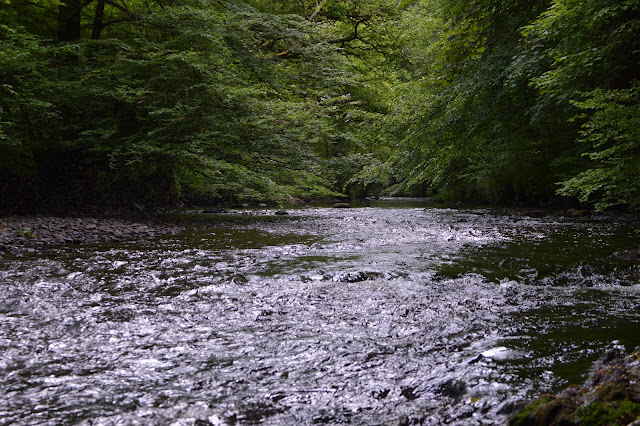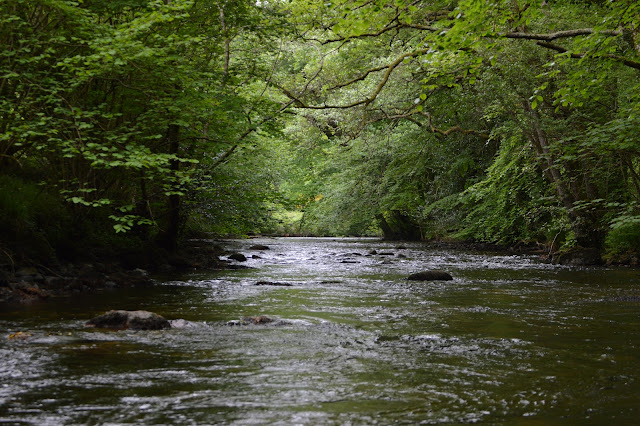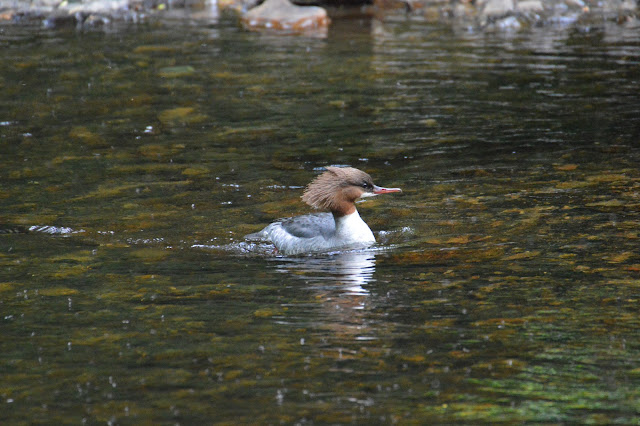Dartmoor, in the South West of England, South West of the County of Devonshire and a yearly pilgrimage to explore it's natural world beckoned.
So many treasures draw me to this ancient idyll. New places open stories unread, but visiting old places well trodden, such as Dunsford, brings expected and unexpected delights and writes new chapters about it.
My two and a half hour journey brought me here at 9am. It was the end of May, warm without direct sunshine and a light breeze.
Dunsford is a village in a river valley carved by the Teign as it slithers a course eventually to the South Devon coast.
Naturally it's filled with a plethora of wildlife and so becomes a Mecca for people to worship at it's alter. None more so than myself. I love this rich landscape nestled in the oak clad hills.
There is a small car park at Steps Bridge. I stay in the van overnight which allows me ample time to explore all the pathways.
Once across the bridge, the footpath takes you along the river into the nature reserve managed by Devon Wildlife Trust.
The lush pale green spring growth reflects beautifully in the slow fresh waters.
Four main paths are up for grabs some 100 metres from the bridge. My first choice this time was the steep path that lifts you into the oak canopy.
The light and textures can change from all angles as you gradually push up the path.
Common Cow Wheat grows everywhere, it loves acid woodland in this part of the world and is semi parasitic, meaning it draws some nutrients from nearby plants.
It has long tubular flowers only accessible by insects with long proboscis. The rare Heath Fritillary butterfly favours it as a foodplant. More of that insect in a later blog but unfortunately Heath 'Frits' are sadly absent from this part of Devon. Cow Wheat can self pollinate if there aren't enough suitable hosts around however.
The adage 'You're never more than 6 feet away from a rat' which was always a little ambiguous and a bit of an old wives tale, can certainly be applied to Wood Ants around here. In fact it would seem 6 inches is a more realistic distance.
Every now and then I would stop and look at the ground and sure enough they would be around my feet.
Their nests are construction wonders of the natural world. This one here is around three feet high with a diameter of some eight feet.
They must walk for quite a distance to forage for nesting material and food. They are visible when there are no nests in view.
They are twice the size of the common garden black ant with the soldiers, that keep guard over the nest and the workers, even larger.
I had wound my way up to the viewpoint where the Trust had conveniently laid a bench to sit and admire the view.
I would have loved to sit but the ants were heaving all around it so I put up with standing !
Not only is it worth the climb for the tremendous views, there is a rare woodland bird that inhabits the upper reaches of the reserve.
I have seen them along the river valley but their preferred habitat is up here... Pied Flycatchers.
They do very well here and once you find a nestbox, it's always worth staking it out in the hope of an occupant.
Having visited these woods for a number of years I know the parts they inhabit and also their short melodic call.
It didn't take me long to find one, albeit a little distant, with the shade of the trees adding to the poor quality shots but it's always a thrill to see this lovely little bird.
This is a male. The female is more dowdy with a brown and cream plumage - no surprise there then ? The females can be mistaken for Spotted Flycatchers which are more prevalent around the country.
The sun kept emerging from behind the clouds much more by now, changing shapes and shades plus the temperature was climbing which was perfect as Butterflies were on my list for the day.
As the temperature climbed, I descended to the valley floor.
The path is interspersed with open glades, allowing sun to penetrate and thus allowing flowers to proliferate.
Bluebells, Red Campion, Ramsons, Yellow Archangel are but a few that thrive here.
My regular seat by the river gives me time for reflection on what has happened in the year since I last sat here. As usual, quite a lot. The loss of my Mum being the one overriding emotion. I like to think she was sat with me and Dad next to her. I found much comfort in that thought.
New life was unfurling everywhere. I love the shapes of the early fern growth as the unwrap themselves from their winter sleep.
I came across a Variable Longhorn Beetle. It allowed me some lovely close up shots...
A favourite of mine and common here is the Beautiful Demoiselle. It can be quite skittish, so a calm approach is required. It wouldn't allow a closer shot however but I was sure I would catch up with one later.
As the path snakes through the glade Black Oil Beetles showed every now and then. It's easy to step on one but hopefully I missed any. This is a male. The females are twice the size.
The smell of garlic was so strong with Ramsons growing in large numbers.
Greater Stitchwort were out in force too.
Tucked away in the low foliage, Yellow Archangel were doing well also.
My butterfly quest usually leads me to the upper south facing slopes at the end of the path but occasionally some can be seen low down in the glades.
I was lucky this time. A Small Pearl Bordered Fritillary was feeding on the Bluebells.
It's wings didn't seem fully formed. Maybe this one was newly emerged from it's chrysalis?
It was quite happy to let me sit next to it snapping away as it fed.
Then another beetle, a Bloody Nosed Beetle. It exudes red liquid in defence. I didn't push my luck to find out and let it go on it's way undisturbed.
Then another insect, a Dock Bug which can be found on Bramble such as in this shot.
Scorpion Flies are a favourite. Lovely wing pattern with a tail to its abdomen shaped like a sting on a Scorpion.
A bird was feeding on the path and flew up into the nearby canopy. It wasn't in a hurry to depart and allowed decent shots to see it was a Tree Pipit. A juvenile too by the looks of it.
Some parts of the Teign can be quite rapid over boulders, a great place to find Dippers. I had no luck thus far but on a stretch like this I was hopeful of decent sightings.
The end of the path opens into a huge glade allowing spectacular views up the hillside and in the sun it makes all the difference.
In March this place is covered with Daffodils. As Spring was late this year, the current Bluebells were hanging on well.
I left the glade and headed for the steep steps to the bracken covered slopes. Perfect Fritillary country...
Pearl Bordereds this time. The 'Smalls' larger cousin...
Small Pearl Bordered were around too.
I headed back down the glade where the Pearl Bordereds' still skitted around my feet on the path.
Back to the river with the reflection from the water lighting up the Sycamore trees nicely.
The Demoiselles' still remained just out of reach. They like to rest on the leaves leaving their silhouette to give the game away.
Then the bird I was hoping for. The Dipper. It had a bill full of grubs plucked from beneath the river surface.
I had found a nest site too. It was out of sight but it was obvious it was there as I sat and waited it would return to the same area and fly up under the bank.
Sometimes when it returned, it would look for food right in front of me. Dropping it's head underwater to see what was about.
As I sat behind the tree I could see another Longhorn resting in the shade.
I had to get up and walk around as my legs were going to sleep. Yet more Oil Beetles crept across the path in front of me.
Another regular sighting on the river is the Goosander. I've only ever seen adults here. I know they breed on inland rivers in Spring but have yet to see any juveniles.
My luck was in again. One chick swam next to the Redhead mother.
I knew that with a flightless chick in tow the mother wouldn't fly away as they do when on their own.
I still kept a discreet distance as the adult would call at me to keep away.
It was learning all the while, copying it's mother in feeding techniques.
When the chick needed to get away fast, it span it's little legs like a wind up bath toy.
I left them be and carried on back to the car park for some lunch.
By Steps Bridge a Grey Wagtail was feeding in the shallows. There are plenty of insects to go around.
After some well deserved sustenance, I walked the river path once more.
Thistles growing in the glades hid Crab Spiders but they do like to tuck away. I tried my best to part the leaves whilst trying to capture an image. Although not too successful, I do like the abstract nature of this shot.
You can just see my quarry keeping well out of the way.
Then the Demoiselles began to play ball...a female.
Happy with my shots, my attention turned to the flora in the glade.
There's nothing like wildflowers in bloom on a warm Spring day.
The Dipper had returned, still in search of food for it's chicks....
This time last year I watched them feeding their fledglings on the shore. It shows what a late Spring it has been.
The day was drawing in. One last sit on the bench and I was off back to the van to prepare for dinner at the local pub in Dunsford Village.
As I reached the climax of the path a female Mallard had a dozen young in tow.
They proved great entertainment as the chased the millions of flies spinning around the river.
Next to me, the discarded shell of an emergent insect hung drying in the cool. Possibly a mayfly but I couldn't be certain.
More Black Oil Beetles too. I've never seen so many in one day !
By now the adult was guarding over the chick as it took a nap on the opposite shore.
I left and immediately stumbled across a bracket fungus. Commonly known as the Chicken of the Woods and excellent to eat. I hadn't brought my frying pan so left it where it was.
I had reached the bridge and almost back to the car park.
I changed for my walk across the fields to the Royal Oak for a couple of jars of ale and a hearty meal.
A Stock Dove sat atop of the electric poles as I passed underneath.
And so into Dunsford for a reflection over a pint on my long day. And what a brilliant day. So much diversity in one place. I was feeling truly blessed.
The title of this post is a line taken from the poem.. Woods and Wildflowers by Linda Ori
https://www.poemhunter.com/poem/woods-and-wildflowers/
































































































































































































No comments:
Post a Comment
Please leave me a message if you would like to do so.